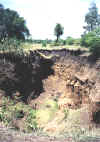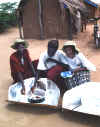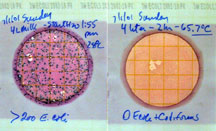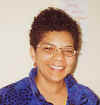| Solar Cookers International... 1919 21st Street, #101 Sacramento, CA 95811 USA Tel. 916-455-4499 Fax 916-455-4498 E-mail: info@solarcookers.org |
Solar Cooker Review November 2002 |
Solar Cooking
Archive: |
|
Volume 8, Number 3 |
|
|
In This Issue |

|
Sunny Solutions: a project for a brighter future
by Pascale Dennery
Program Manager, SCI
 |
|
Nyakach women's groups, working closely with NYACODA, will play an integral role in solar cooker promotion |
In early 2003, Solar Cookers International (SCI) will launch a new project in Kenya called Sunny Solutions. In contrast with SCI's projects in refugee camps, this one will be in a settled community. While cookers have often been distributed in refugee camps for little or no cost, in this new project cookers will be sold. Local people will receive training to teach solar cooking skills and to sell solar cookers with the aim of earning an income by promoting solar cooking.
Extensive planning for the project took place during the summer and fall of 2002. Organizations from over 120 communities responded to the posting of a call for applications in the Daily Nation, one of Kenya's national newspapers. After an initial review by SCI's regional office staff in Nairobi, I narrowed the pool of candidates to three finalists based on SCI's criteria for choosing partner organizations. In August, SCI's Nairobi-based program coordinator, Solomon Okumu, along with volunteer Simon Ogutu, visited two of the possible sites, while the third site was visited by Solomon and SCI's field assistant, Faustine Odaba.
And the verdict is ...
The Sunny Solutions project site is the community of Nyakach, located 60 kilometers from the equator near lake Victoria and the city of Kisumu. The community has a large population of farmers, but also has a significant number of families that work in the fishing industry. A number of small businesses -- some run by women -- provide food and other necessities. The area is highly deforested due to the cutting of trees and bushes for cooking fuel. To meet their energy needs, Nyakach families use a mixture of crop residues and dung or purchase wood and charcoal imported from the Rift Valley and other parts of Kenya. The area truly needs a solar cooking and water pasteurization project -- the ecosystem is degraded, waterborne illness is prevalent, and the region receives plenty of sunshine. Community residents have also been adversely affected by a high incidence of HIV/AIDS.

Sunny Solutions will be implemented with a local partner, the community-based organization Nyakach Constituency Development Association (NYACODA). NYACODA was selected because of its strong track record and capacity to implement projects. It has 4,000 members of which 70 percent are women. NYACODA has previously collaborated with Winrock International on a seed production project and worked with Honey Care International and other nongovernmental organizations on a bee-keeping project.
SCI expects that 1,100 households, or six percent of the population of Nyakach, will have solar cookers and will be skilled in their use within three years. During this period, SCI and NYACODA will carefully monitor the learning process and the amount of solar cooker usage by participants to be sure that families are able to maximize their solar cooking skills. After three years, project management will be turned over to NYACODA personnel, who will have been trained to be able to continue spreading solar cooking after SCI reduces its involvement.
Kakuma refugee camp
Elsewhere in Kenya, SCI is continuing with its solar cooking project in Kakuma refugee camp. Distribution of the already inadequate rations of fuel wood at the camp came to a halt in March -- due to an impasse between the wood suppliers and the camp administration -- and was not revived until August. Unfortunately, this lack of fuel wood coincided with a scaling back of food rations, so, although many refugees wanted to solar cook, there was little food to cook. Nonetheless, all was not lost. Refugees who previously had not fully grasped the value of solar cookers began to understand their usefulness as money-, time-, and fuel-saving devices, and have since signed up for training. SCI has been working with the GTZ (German Technical Cooperation) organization to raise environmental awareness and conduct demonstrations on fuel wood-saving techniques. New Somali and Sudanese arrivals attending these demonstrations have shown a lot of interest in solar cookers, mud stoves and other fuel wood-conservation devices. SCI is currently providing training to these refugees. SCI is also introducing solar cooking to the next generation of solar cooks -- students in schools in and around Kakuma.
SCI trainers demonstrate the CooKit solar cooker in Kakuma refugee camp
SCI is continuing its work in Aisha refugee camp in Ethiopia, though the project has been scaled back somewhat since all interested families -- approximately 95 percent of the entire camp -- have now received solar cooking training. Refugees at the camp are currently awaiting the arrival of another 1,000 Kenyan-made CooKit solar cookers. SCI's efforts to have CooKits manufactured in Ethiopia have had minimal success due to the limited manufacturing base of that country and the poor quality of materials such as cardboard, reflective materials and adhesives.
Somalia
SCI's eastern Africa regional office is helping the Adventist Development and Relief Agency International (ADRA) to incorporate solar cooking into their community development programs in Somalia. The first step in this process was the participation of ADRA staff members in SCI's water testing and water pasteurization workshop that took place in Nairobi in July 2002. Next, Margaret Owino of SCI's Nairobi office and Nadir Aden Hassen, project coordinator for the Aisha refugee camp project, led a solar cooking workshop at an energy fair in Hargeysa, Somaliland (Somalia) in October 2002. The Somali diet is particularly well suited to solar cooking. Helping organizations such as ADRA, which already serve specific communities, is one way for SCI to have a multiplier effect and spread solar cooking and water pasteurization to new communities.
by Robert Metcalf, Ph.D.
SCI volunteer
Millions of people become sick each year from drinking contaminated water. Children are especially susceptible. An estimated 1.5 billion cases of diarrhea occur each year, resulting in the death of nearly 2 million children. Worldwide, about 1.3 billion people do not have access to safe drinking water, including nearly half the population of sub-Sahara Africa. Yet, in many of the most severely effected regions, sunshine is an abundant source of energy that not only can cook food, but can also heat water to temperatures that kill harmful microbes, making water safe to drink. This procedure is called solar water pasteurization.
E. coli bacteria (left plate) thrive in water sources, but are easily killed through solar water pasteurization (right plate)
It has been known since the late 1880s, when Louis Pasteur conducted groundbreaking research on bacteria, that heat can kill pathogenic (disease-causing) microbes. Most people know that contaminated water can be made safe by boiling. What is not well known is that contaminated water can be pasteurized at temperatures well below boiling, as can milk, which is commonly pasteurized at 71°C (160°F) for 15 seconds.
The chart below indicates the temperatures at which the most common waterborne pathogens are rapidly killed, thus resulting in at least 90 percent of the microbes becoming inactivated in one minute at the given temperature. (The 90 percent reduction is an indicator frequently used to express the heat sensitivity of various microbes.) Thus, five minutes at this temperature would cause at least a 99.999 percent (5 log) reduction in viable microbes capable of causing disease.
| Microbe | Killed Rapidly At |
| Worms,
Protozoa cysts (Giardia, Cryptosporidium, Entamoeba) |
55°C (131°F) |
| Bacteria
(V. cholerae, Escherichia coli, Shigella, Salmonella typhi), Rotavirus |
60°C (140°F) |
| Hepatitis A virus | 65°C (149°F) |
(Significant inactivation of these microbes actually starts at about 5°C (9°F) below these temperatures, although it may take a couple of minutes at the lower temperature to obtain 90 percent inactivation.)
Solar water pasteurization
Solar cooks know how easy it is to heat foods in a solar cooker to temperatures well above 60°C (140°F). Knowing this, a graduate student of mine in the early 1980s, David Ciochetti, studied solar water pasteurization for his master's thesis. David and I found that when contaminated water was heated in a black jar in a solar box cooker, both bacteria and rotaviruses -- the main cause of severe diarrhea in children -- were inactivated by 60°C (140°F). In the paper we published on David's work (Applied and Environmental Microbiology, Vol. 47:223-228, 1984) we concluded that if contaminated water were heated to 65°C (149°F), all pathogenic microbes would be inactivated. This includes the hepatitis A virus, which has a 90 percent reduction after two minutes at 60°C (140°F).
Another student of mine, Negar Safapour, found that contaminated water could be pasteurized in a black metal or glass container in a CooKit (SCI's simple solar cooker) without using the clear plastic bag that is required for cooking. In our experiments it took about three minutes for each 1°C increase from 55°C to 65°C when heating 2 liters of water, and four to five minutes for each 1°C increase when heating 4 liters. Thus, water is at lethal temperatures for a number of minutes as it is solar heated to 65°C (149°F), and it remains in the lethal zone for many more minutes as the water slowly cools back down to 55°C (131°F).

Since thermometers are not accessible to many people around the world, there is a need for a simple device that indicates when water has reached pasteurization temperatures. Fred Barrett, who was with the United States Department of Agriculture when I worked with him on a solar box cooker project in Sierra Leone in 1989, came up with the idea of using vegetable wax, with a melting point near 70°C (158°F), as an indicator. He built several models based on the idea of wax inside a plastic cylinder, and we successfully used them to verify pasteurization conditions of contaminated water. A couple of years later, Dale Andreatta -- a Ph.D. candidate in mechanical engineering at the University of California, Berkeley at the time -- created the Water Pasteurization Indicator (WAPI) in its current form. The WAPI is a clear plastic tube partially filled with a soybean wax that melts at about 70°C (158°F). With the solid wax at the top end of the tube, the WAPI is placed in the bottom of a black container of water that is solar heated. If the wax melts and falls to the bottom of the tube, it ensures that water pasteurization conditions have been reached. The WAPI has a stainless steel washer around it to keep it at the bottom of the container, which is the coolest location when solar heating water. Since top water temperatures are often 2-5°C hotter than bottom water temperatures, lower WAPI placement helps to further insure that pasteurization conditions have been achieved.
SCI's WAPI shown in the solid wax state (left) and liquid wax state (right)
The past three summers I have had the opportunity to conduct numerous solar water pasteurization experiments in Meatu district, Shinyanga region, Tanzania, where I've been an SCI volunteer and worked with AHEAD, Inc., a nongovernmental organization headed by SCI board member Elvira Williams. AHEAD provides monthly health outreach services to 17 remote villages in Meatu district. Water in Meatu villages most often comes from open holes dug in the sand of dry riverbeds, and it is invariably contaminated. Indeed, the water that was provided in our guesthouse was heavily contaminated. Bacteriological tests of the water during solar pasteurization repeatedly showed indicator bacteria (key bacteria whose presence indicates fecal contamination) becoming inactivated at temperatures just below 60°C (140°F). I was so confident that water heated to 60°C was safe that I allowed it to cool and used it as my own drinking water for the two weeks I was in Meatu in 2002. I had no intestinal problems.
Meatu resident Boniphace Luhende demonstrates solar water pasteurization using a CooKit and WAPI
SODIS
An alternative solar method of inactivating microbes in contaminated water -- exposing transparent bottles of water, placed horizontally on a flat surface, to direct sunshine for five to six hours -- was first reported in 1980 by Aftim Acra et al. at the American University of Beirut in Lebanon. UNICEF published a booklet describing this method in 1984. This procedure has recently been named SODIS (short for "solar disinfection") by the Swiss Institute for Environmental Science and Technology. The institute recommends painting half of the bottle black, or placing the clear bottle on a dark metal surface, to enhance heating and increase microbe inactivation (see www.sodis.ch). The World Health Organization (WHO) has endorsed the SODIS procedure.
The SODIS procedure will inactivate bacteria on sunny days. However, it does have some limitations. The SODIS method cannot be used for turbid water or for milk, since turbidity and non-clear liquids reduce solar radiation intensity. Also, my students and I have found that viruses are more resistant to direct sunshine than are bacteria. Research conducted by Negar Safapour and myself, using a bacterial virus, supports this. (See our paper in Applied and Environmental Microbiology Vol. 65, #2, pp859-861, 1999; available online at: http://aem.asm.org.) Another student of mine, Yen Cao Verhoeven, studied the effects of the SODIS method on rotaviruses, with similar results. Her findings were presented as a poster at the American Society for Microbiology annual meeting in May 2000. Furthermore, the SODIS method suffers because it has no certain end-point. How does one know if the pathogens have been completely inactivated if there is only partial sunshine, or the water is moderately turbid? It's a guess.
This past summer Christine Polinelli, from the Australian Department of Health, joined me in Meatu district to test CooKit water pasteurization, and the SODIS method, with the naturally contaminated water delivered to our guesthouse. This water had between 10-100 E. coli bacteria per milliliter. (The WHO considers water to be heavily contaminated if it has 1 E. coli per milliliter.) Water heated in a 2-liter black metal container in a CooKit was free of E. coli within 2 hours, when temperatures reached 60°C. Water from the same source was given the SODIS treatment in the 1.5-liter blue-tinted plastic bottles available in Tanzania. Although we obtained over 90 percent inactivation of E. coli in 5-6 hours, viable E. coli were still sometimes present in 1 milliliter and 10 milliliter samples. The moderate turbidity of the river water may have contributed somewhat to protecting E. coli.
SODIS experiments using common plastic bottles were mostly successful, but small amounts of E. coli survived
Sari cloth filtering
In Bangladesh, cholera is a threat, particularly around the spring and summer monsoons. Some of the cholera bacteria attach to much larger -- but still microscopic -- plants and animals, which could possibly be filtered out of water. This has led to the recommendation to filter water through 8-10 folds of sari cloth (see National Geographic, February, 2002, p. 20). In Meatu district, Christine and I tested 8 different cloths, folded 8 and 12 times. As we expected, for all 8 cloths, the E. coli bacteria in the filtrate was equal to the concentration before filtering. Unattached bacteria, and likely viruses, which are a fraction of the size of bacteria, go through folded cloth like air molecules go through a screen!
I have always considered the gold standard of microbe inactivation procedures to be: Will the person recommending a specific procedure actually drink heavily contaminated water which has been treated by the particular method? I will, and have, with solar water pasteurization using a CooKit and WAPI. Certainly the folded sari method is dangerous. The SODIS method is effective at reducing viable bacteria. However, its ability to inactivate viruses, particularly the dangerous rotavirus, is less certain. And there is no inexpensive, easy device that indicates when SODIS-processed water is safe to drink.
Most of the people I've talked to about solar water pasteurization oven the past 20 years are astonished to learn that water does not have to be boiled to make it safe microbiologically. The fact that the WHO, the Center for Disease Control (CDC), and the Peace Corps routinely recommend boiling suspect water -- sometimes for as long as10 minutes -- reinforces the myth that water needs to be heated drastically more than milk to kill pathogens. One reason for boil orders, Dave Ciochetti and I speculated 20 years ago, is that without a thermometer, it is not possible to judge the temperature of heated water. What the world needed was the WAPI, which SCI now manufactures. The SODIS method includes recommendations to boost water temperatures to 55°C (131°F) if possible, which greatly increases killing of bacteria. What is not well known is that the alternative to direct sunshine to pasteurize water is not boiling, but modest temperatures in the 60°C range, which are easily obtained using simple solar cookers. When it becomes common knowledge that 60-65°C (140-149°F) will guarantee all pathogens are killed, and boiling isn't needed, the CooKit and WAPI approach should become much more prominent. (Note that solar water pasteurization requires a container other than plastic, which starts to melt near 60°C.)
Another major reason to promote the CooKit/WAPI method of solar water pasteurization is that in most of the places where water is unsafe, people also use fuel wood for cooking, as they do in Meatu district. Women have to spend hours collecting scarce firewood every two or three days, and then spend more hours tending a smoky fire. The SODIS method doesn't inform 2.5 billion people who depend on traditional fuels that with sunshine, there is an alternative to fire.
In advocating for the spread of solar cooking, the many thousands of solar cooks who read the Solar Cooker Review might find that solar water pasteurization will open doors that the cooking function alone hasn't been able to open. That has happened the last two years in Tanzania, and this past July in Nairobi, Kenya, when Christine and I worked with SCI's eastern Africa staff to hold a three-day presentation and workshop on water testing and solar water pasteurization. We look forward to expanding these efforts in the future.
Contact: Dr. Robert Metcalf, Department of Biological Sciences, California State University Sacramento, Sacramento, California, 95819-6077, USA. E-mail: rmetcalf@csus.edu
You can listen to a recent interview with Dr. Metcalf here.
Moving forward on different fronts
by Terry Grumley
Executive Director, SCI
During a month-long trip to Africa last August, I was again reminded of the continuing worldwide depletion of trees and vegetation and the harsh conditions under which a major portion of the world's population live and work. I also witnessed, once again, the vibrant spirit with which people struggle against those conditions.
A review of the statistics of ever-dwindling natural resources and crushing poverty provide a challenging context. The gap in the standard of living between the developed world and the underdeveloped world gets wider every year. Nearly half the world's population subsists on less than two dollars a day while one billion people live on less than a dollar a day. According to the Food and Agriculture Organization (FAO) of the United Nations, as much as half the world's 2 billion fuel wood users face fuel shortages and 100 million "already experience virtual fuel wood famine." Almost one of every two Africans lacks access to safe drinking water.
The statistics, though daunting, do not hit as hard as seeing their manifestation first-hand -- to see in western Kenya the washed out gullies cutting off road access and water supplies to communities; to see people cooking with animal waste and crop residues while women, backs bent, carry off freshly cut live bushes and saplings from the scarce vegetation remaining; to see the increased suffering of families in Zimbabwe who have to pay more and more for fuel wood while enduring critical cuts in household income aggravated by skyrocketing inflation, shortages of food and fuel supplies and political turmoil.
More impressive than the problems, however, is the indomitable manner in which people respond to those problems. I've seen active community groups and leaders working together to educate their neighbors about conservation practices; I've seen community groups working hard to link with other organizations that bring appropriate new technologies that help improve the lives of local residents; I've seen small-business women taking new ideas and expanding their business networks to sell solar cookers and hay baskets (heat-retention cookers).
It is reassuring to be part of an organization that provides a means for people to fight back and respond constructively to the difficulties in their lives. It is heartening to be able to share technologies that address not just the environment, but also poverty and health. These issues are closely intertwined as was reinforced at the recent World Summit on Sustainable Development (WSSD) in South Africa where leaders from all realms came together to attempt to chart a course forward for balancing use of the world's limited resources.
The issues concerning sustainable development are complex just as the living conditions are extremely harsh for the majority of people living in developing countries. We are trying to address both through our efforts at Solar Cookers International. During my trip, I took part in activities that are described within this edition of the newsletter. Danielle Kahn describes how SCI volunteers and staff, along with other solar cooking organizations at the World Summit on Sustainable Development, worked to raise awareness of the need for -- and the benefits of -- solar cooking and solar water pasteurization efforts. Pascale Dennery, SCI's program manager, describes efforts being made in western Kenya to address the erosion, deforestation and poverty experienced by residents in Nyakach province.
Our new Sunny Solutions project provides an invaluable opportunity to apply the lessons learned and guidelines developed from projects started earlier. In addition, Robert Metcalf, SCI founder and volunteer, explains the progress being made in developing water testing and water pasteurization technologies through his work in Tanzania with the AHEAD organization and in Kenya with SCI staff.
In all of these efforts, SCI helps people fight back on different fronts, both individually and in concert with others. The efforts are not always an immediate success, but some of the most important learning comes from initial failures. The important thing is to develop a process and structure wherein we can observe, identify and apply the lessons learned from both successes and failures.
That is where we are headed as an organization. Our strategy is to increase our capacity for learning through both our own projects and projects of others, with an increased emphasis on monitoring and evaluation. We will apply that learning through the publication of updated guidelines to assist others in spreading solar cooking and solar water pasteurization technologies. At the same time, through increased effectiveness in documenting the success of projects within the field, we will make a stronger case for getting larger organizations to fund and support greater spread of solar cooking.
Over the last year, we have added to our box of measurement tools and project guidelines. We have gained stronger evidence of the benefits of solar cooking projects and have increased the number and qualifications of staff. In the future we will formally identify a network of volunteers with qualifications to support a wide range of solar cooking and solar water pasteurization efforts.
We look forward to reinforcing our relationships within the field and to increasing our effectiveness in responding to the needs of solar cooking activists and promoters.
Can you afford to be generous?
Solar Cookers International is making a world of difference. Your contribution will be gratefully received and used to strengthen the spread of this solar solution on behalf of people and the planet.
Please consider these giving options:
Spreading the word
Recruit potential members by asking interested friends, "Did you know that a forty dollar contribution to SCI provides cookers and cooking supplies for a refugee family?" or, "Did you know that twenty-five dollars provides food for two workshops lead by local refugee trainers?"
SCI in your will
"I give and bequeath to Solar Cookers International of Sacramento, California $______ (or ______% of my estate) to be used for its humanitarian purposes."
Investing in SCI
If you have a choice between donating appreciated stock or cash to SCI, there are two tax advantages of donating stock. First, you receive an income tax charitable deduction for the full market value of the stock at the time it is donated. Second, you avoid paying any capital gains tax on the increase in value of the stock. You can invest in SCI and invest your cash in current stock. It's a win-win situation!
Contact Virginia Callaghan at (916) 455-4499 to discuss donations and stock transfers. Consult your financial planner for additional information. Thank you.
Two hundred people attended Solar Cookers International's 4th annual Shine On! event this past August at the Sacramento Zoo in Sacramento, California (USA). The event is designed to share SCI's worldwide activities with local supporters and to increase knowledge of solar cooking and solar water pasteurization on the local level. Attendees explored SCI's activities through various displays and interaction with staff and volunteers. They were also treated to an array of solar-cooked desserts. SCI volunteer and past board member Dr. Robert Metcalf once again delivered an energized and informative presentation on solar cooking and solar water pasteurization in Tanzania. Many thanks to all those helped make this event a huge success!

Tribute gifts have been given to SCI by:
Carol N. Gerlitz and Bill Braddock in honor of their son, Eric S. Johnson
Doug Garrett (and relatives) in honor of his mother, Jean Garrett
Gwynne P. Smith in memory of her parents, George and Gertrude Prosser
Mr. and Mrs. Keith McFarland in memory of Phil Whalen
Sam and June Sale in honor of Ellen and Bert Witt
The Oklahoma Ethiopian Society in memory of Virginia Little
Rosalyn Rappaport in memory of Mohammed Bedi
Marjorie McKisson in memory of Ms. Keiswetter
Nancy and Peter Breitling in honor of Amy Robinson and Chris Schaefer
Benjamin Lawrance in honor of Amy Robinson and Chris Schaefer
Susan Duncan in memory of Phil Strauss
Solar cooking at the Johannesburg Summit
by Danielle Kahn
SCI volunteer

Deling Wang (pictured), along with volunteers Keshav Jaini and Herliyani Suharta, attended WSSD preparatory meetings on SCI's behalf
Using the CooKit, a lightweight, foldable and inexpensive panel-type cooker, SCI demonstrated solar cooking and solar water pasteurization techniques almost every day of the ten-day summit, as well as the preceding weekend. Demonstrations were held at the Sandton Convention Center, Ubuntu Village, and NASREC, where most nongovernmental organizations (NGOs) held their activities, generating interest from NGOs and government delegates representing numerous developing and developed countries. At Ubuntu Village, the GTZ (German Technical Cooperation) organization allowed SCI to demonstrate the CooKit at its Unplugged Kitchen, a restaurant featuring solar-cooked chicken, stews, beans, mashed potatoes, sausages, bread and cake. SCI also had the opportunity to demonstrate one of GTZ's parabolic cookers alongside the CooKit at the Sandton Center.
Gabi Cook, a solar cooker promoter living in South Africa who has spread solar cooking in Iran and Pakistan, among other places, shows off solar cookers and a heat-retention cooker with Terry Grumley and Margaret Owino
The Johannesburg Summit was enormous, with 17,000 delegates attending the main conference and thousands more participating in parallel events. In addition to efforts by SCI and GTZ, several other solar cookers were on display by Greenstar and other exhibiting organizations at Ubuntu Village. The visibility of solar cookers at the Summit helped to attract media, NGO and government interest in solar cooking as a solution to help relieve the conflict between people's basic needs and earth's dwindling forests. While the final outcome of the Summit may not represent a success for renewable energy interests, nor for the provision of electrical energy services to the 2 billion people worldwide who lack access, hopefully the enthusiasm solar cooking has generated as a simple, elegant tool that empowers people to reduce fuel wood dependence, poor drinking water quality, deforestation, biodiversity loss and global warming pressures will carry beyond the Summit. In addition, it is worth noting that the Summit's Plan of Implementation commits parties to halving the number of people without access to clean water by 2015. Solar water pasteurization can play a role in this. Regardless of the outcome of the documents produced by the Summit, the solar cooking community's efforts will be reinforced and strengthened by increased public awareness and commitment to environmental issues and sustainable development resulting from efforts at the World Summit on Sustainable Development.
Contact: Danielle Kahn, e-mail: danikahn80@hotmail.com
In the July 2002 Solar Cooker Review article entitled "Afghanistan: return of solar cookers?" we erroneously implied that Virginie Mitchem was Laila Petty's primary solar cooking instructor. In fact, Allart Ligtenberg conducted the initial trainings, and Ms. Mitchem took over when Allart became unavailable. We regret the error and apologize to the parties involved.
AFRICA AND EUROPE
Benin
Solar advocate Vincent Nnanna has organized a solar cooking club in Cotonou. Club activities include the building of solar cookers, dissemination of solar cooking knowledge, and general advocacy for solar energy within the region. Meetings are held on the first and third Fridays of each month, and membership is free and open to all.
Contact: Vincent Nnanna, Carré Ambassade du Nigéria, BP 2019, Cotonou, Republic of Benin. E-mail: vinfish@hotmail.com, tel: 00229444619.
The Gambia
Rosalyn Rappaport reports that the Marakissa Solar Cooks Club has been quite active. As planned, they have begun to give solar cooking demonstrations in surrounding communities, including Nyofelleh, Bajonkoto and Kasa Kunda. Group leader Anna Bass reports that they receive many requests. Demonstrations are arranged through an existing Methodist network. Recipient communities are asked to submit follow-up reports outlining progress made. Reports thus far have been favorable. Commonly cooked foods include rice, fish, tomatoes, peppers, onions and cassava.
Club members have used a combination of solar box and panel cookers over the years. Wooden panel cookers have proven useful because they are portable enough to take into the fields when working. However, suitable cooking bags, which surround the cooking pot and hold in heat in this type of cooker, are difficult to find near Marakissa. Ms. Rappaport said they have now found a local manufacturer of inexpensive bags.
Contact: Rosalyn Rappaport, 31 Lodge Lane, London N12 8JG, England. Tel: 020 8446 3690.
The Netherlands
J.D. Bruin, of the Solar Cookers Sliedrecht working group, reports that the Dutch Minister of the Environment, P.J. Pronk, has expressed an interest in studying the effects of increased solar cooker usage on global carbon dioxide levels. With favorable results, the Minister may explore the possibility of stimulating solar cooking projects in developing countries to reduce the amount of carbon dioxide -- a by-product of cooking over fire -- that is released into the atmosphere.
The Solar Cookers Sliedrecht working group has been promoting solar cookers for nearly 10 years. Initially, the goal of the group was to prove that solar cooking is possible at higher latitudes. They have done that, and now concentrate on supporting the introduction and production of solar cookers by providing advice and, in some instances, financial assistance. They particularly like the Dierkx wooden box cooker from Holland.

Contact: J.D. Bruin, Kromme Stoep 13, 3361 CH Sliedrecht, Netherlands. Tel: 31-(0) 184-412545, e-mail: japdebruin@hetnet.nl
Nigeria
Rev. E.A. Ekong, a pastor in a remote part of Akwa Ibom state, is experimenting with the CooKit and sharing the simple technology with his youth group and community. "The children are so funny," he says. "They watch in earnest to see how the sun could cook. Smile, Smile!! We cook beans, rice, yams and vegetables."
Contact: R.D. "Del" Anderson, 1131 Via Alamosa, Alameda, California 94501, USA.
Tanzania
Solar Cooking Zanzibar, a project of the Zanzibar Ministry of Agriculture's Department of Commercial Crops, Fruits and Forestry, reports that the Kizimbani Agricultural Training Institute has incorporated solar cooking into its curriculum for agronomy students. Students construct and use solar cookers and research various aspects of solar cooker design and use. One recent project involved procuring suitable insulation materials from local sources. Solar Cooking Zanzibar is hopeful that the solar cookers will also be incorporated into the institute's kitchen, which currently cooks 80-person meals over large fires.
Contact: Antje Förstle and Rainer Vierkötter, P.O. Box 152, Zanzibar, Tanzania. Tel: +255 (24) 225 05 42, e-mail: solarafrica@zanzinet.com, web: www.solarafrica.net
THE AMERICAS
Brazil

Contact: Arnaldo Moura Bezerra, e-mail: mourabezerra@hs24.com.br
Cuba
Alberto de la Paz writes that solar cooking has become quite popular in parts of Cuba, particularly in the countryside. He is currently collecting information about solar cooking so that he can teach others.
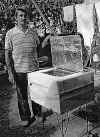
Contact: Alberto de la Paz, Damas #858, E/Merced y Paula, Habana Viesa, Zona 1, Cuba.
Ecuador
Dr. Fabiola B. Cuvi, director of the Ecuadorian Research and Training Institute of Women (IECAIM), reports that the Institute has published two small books on solar cooking and box cooker construction. Five hundred copies of each were printed. The books are distributed to IECAIM pupils who attend the solar cooking course "Methodology, Constructions and Use of the Solar Cooker" held in Quito. During this course, students learn to build and use a solar cooker, test the cookers with various foods, and are introduced to the idea of starting small solar cooker businesses. Since 1994, nearly 1000 people have learned about solar cookers through the efforts of IECAIM, and four micro-enterprises have begun whereby women construct solar cookers and sell them for income.
Contact: Dr. Fabiola Cuvi, IECAIM, Av. 6 de Diciembre 2817 Y Republica, Quito, Ecuador. Tel: (593-2) 2 525517, fax: (593-2) 2 569397, e-mail: fabiolacuvi@hotmail.com
Mexico
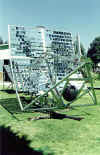
Contact: Ing. Antonio Urbano Castelan, e-mail: jurbano@mail.cinvestav.mx; Martin Jimenez, e-mail: jmartin@gap.sees.cinvestav.mx
United States
Washington

Contact: Martin Nix, P.O. Box 95173, Seattle, Washington 98145, USA.
ASIA AND PACIFIC
Australia
Noel Bourke reports that he has been making and selling solar cookers in Western Australia since 1994. He produces about 45 cookers per year. He is also skilled in solar cooker repair.
Contact: Noel Bourke, e-mail: bourke1950@telstra.com
India

Contact: V.K. Desai, Aadhunik Global Energy Centre, c/o Tinytech Plants, Tagore Road, Rajkot - 360 002, India. Tel: 91-281-480166, fax: 91-281-467552, e-mail: tinytech@tinytechindia.com, web: www.tinytechindia.com
Japan
Yasuko Torii writes that a solar cooking mailing list has been organized in Japan. Thus far, the group consists primarily of people living in Tokyo.
Contact: Yasuko Torii, e-mail: y-torii@a5.ctktv.ne.jp
Nepal
Sanu Kaji, designer and promoter of solar energy products, has designed a panel-type solar cooker similar to SCI's CooKit. The cooker is made from 13 panels of plastic fiberboard, covered with aluminum foil, and joined with aluminum reflective tape. It is foldable, weatherproof, and large enough to cook multiple pots at once. The cooker is being marketed through Foundation for Sustainable Technologies (FoST), a new nongovernmental organization started by Mr. Sanu.
Sanu Kaji's panel cooker cooks multiple pots of food at one time
The back of the cooker reveals how the panels are joined
Contact: Sanu Kaji, e-mail: fost@ntc.net.np
Classroom innovation leads to solar enthusiasm
Students at Miami Country Day School in Miami, Florida, learn about solar cooking at a very young age -- four years old, to be exact. That is the age when the youngest students begin to explore the possibilities that abound when the sun's energy is exploited for cooking and water pasteurization. "Granted," instructor Rowena Gerber says, "the four year old will most likely hand you his super-melted crayon biscuit he made in his 'sun trap', but ... that same child will be designing his own unique solar cooker by the tender age of eight."
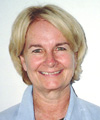
The innovative Rowena Gerber, director of The Abess Center for Environmental Studies at Miami Country Day School, leads students ages 4-12 through a project-based curriculum that encourages critical thinking and questioning and allows children to explore a fascinating range of subject matter in a hands-on manner. Students assume the roles of scientists, journalists, illustrators, poets, teachers, cooks and young socially conscious entrepreneurs, among other things.
For years Ms. Gerber's students have traveled to New York for the annual YouthCaN conference to present solar cooking workshops to over 1000 students exploring environmental issues and solutions. In preparation for the workshops, her students research the history of solar cooking, study the environmental and social implications of cooking with traditional fuel sources, write poems and songs about solar energy, and design solar cookers. In addition, the students recently presented solar cooking workshops to children from over 100 countries at the International Children's Conference on the Environment held in Canada.
Miami Country Day School students are active in "real world" solar cooking projects as well. They produce and sell herbal vinegars, solar-infused oils, salsa, and many other food items from gardens they plant and tend at the center. With money from these sales, the students have been supporting a solar cooking project in Haiti for the past eight years. More recently, they have partnered with Rotary International to help fund solar ovens for refugees in Afghanistan. These are the high-capacity Villager ovens produced by Sun Ovens International, costing over US $10,000 each. To date at least five of the ovens have been shipped. The funds raised by students for this effort already approach US $4000!
One of a handful of Villager ovens that are now being used in Afghanistan
Rowena Gerber was recently presented with an Excellence in Teaching grant from Curriculum Associates, based on her efforts to incorporate solar cooking into the classroom. We congratulate her and her students and colleagues for this honor, and thank them for all their wonderful work and dedication.
A couple of Rowena's students show off a solar box cooker in the making
Contact: Rowena Gerber, Miami Country Day School, P.O. Box 380608, Miami, Florida 33238-0608, USA. E-mail: gerberr@mcds.pvt.k12.fl.us, web: www.miamicountryday.org/aces
Solar Cooker Review is published two or three times per year, with the purpose of presenting solar cooking information from around the world. Topics include solar cooker technology, dissemination strategies, educational materials, and cultural and social adaptations. From time to time we cover related topics such as women's issues, wood shortages, health, nutrition, air pollution, climatic changes, and the environment.
Solar Cooker Review is sent to those who contribute money, or news about solar cooking projects. The suggested subscription price is US $10/year. Single copies are sent free to select libraries and groups overseas. Back issues are available online here: http://solarcooking.org/docs.htm
We welcome reports and commentary related to solar cooking for possible inclusion. These may be edited for clarity or space. Please cite sources whenever possible. We will credit your contribution. Send contributions to Solar Cookers International, 1919 21st Street, Suite 101, Sacramento, California 95811-6827, USA. You may also send them by fax: (916) 455-4498, or e-mail: info@solarcookers.org
Solar Cooker Review is compiled and edited by the staff of Solar Cookers International (SCI), with layout graciously provided by IMPACT Publications located in Medford, Oregon, USA.
SCI is a 501(c)(3) nonprofit organization assisting communities to use the power of the sun to cook food and pasteurize water for the benefit of people and environments. We do not sell, rent or trade names of our donors. Tax ID # 68-0153141.
Solar Cookers International
1919 21st Street, #101
Sacramento, CA 95811, USA
Tel: +1 916-455-4499
Fax: +1 916-455-4498
Email: info@solarcookers.org
Web: http://solarcooking.org
Board of Directors
- David Anderson
- K.C. Bishop, PhD
- Beverlee Bruce, PhD
- Dick Cochran
- John Collentine, JD
- Paul Funk, PhD
- Joyce D. Hightower, MD
- Gary Hursh, JD
- Barbara Knudson, PhD
- Joseph McCabe, PE
- Virginie Mitchem
- Judith Ricci, PhD
- Meredith Richardson
- Carolyn Ristau, PhD
- John Roche
- Jim Uhl
- Elvira Williams
SCI assists communities to use the power of the sun to cook food and
pasteurize water
for the benefit of people and environments.
